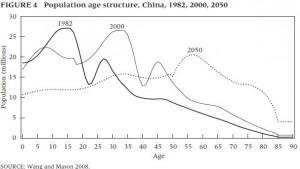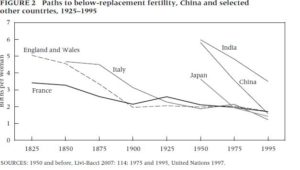I recently came across an interesting paper at Brookings by Wang Feng, The Future of a Demographic Overachiever: Long-Term Implications of the Demographic Transition in China. The title of the paper is self-explanatory as to the subject. Through his research, Wang found a consistent continual demographic decline in China. This is not necessarily news, but the most interesting thing is how this shit came about. It is not as simple as the One Child Policy “did it”. Regardless of the genesis, it is clear that the demographic decline will have a direct affect on China’s future economic productivity, social welfare policies, and general cultural norms in regard to old-age and marriage. China is in a situation where it has to grow and diversify its economy to provide a stable economic structure for its rapidly aging population; there appears to be a short window for this to happen.
China is currently the second largest aggregate economy in the world, and also its most populous nation with 1.34 billion people. This is about 4/5 more populated than the United States, but with ~3.5% less arable land (at 14.9%) and 16% of the spending power (US$7,519 per capita/PPP). About 49.7% of Chinese live in cities today, a number which already rose from 36% just a decade ago. Many of those were young migrants attracted to rich urban areas, especially along the eastern seaboard. Perhaps the most telling figure, more than 220 million Chinese had worked away from home for over six months in 2010, almost double the previous figure.
Like many industrialized nations, of which China is not, its fertility is below replacement level (2.1 children), and it’s population growing rapidly older. This is profound if one looks at China’s demographic history over the previous century; much has changed. In 1950, the average life expectancy in China was 46, this was almost thirty years below the average developed nation of the same period. The death rate during from this time has dropped from 18 per 1,000 to 7.6. By the year 2000 average life expectancy was 70, which placed China only about 5 years behind the U.S.
 Better nutrition and healthcare can account for the extended life spans seen over the last century, but historically China was quite fecund. Could the implementation of the One Child Policy in 1979 account for the capricious decrease in fertility? When China carried out its first census in 1959, the country had 594 million people, less than half the current number. During this time, China experienced rapid population growth, because fertility remained high, having the population double ever 25 years, which was encouraged by Mao Zedong, as a means of Chinese defense from invasion by the Soviet Union or the United States. China would simply be too large and populous to invade successfully, something that might have already been the case during WWII (ask the Japanese). Although China has long been heavily populated, due to extremely productive rice farming, rates of growth like this were largely unknown in Chinese history, a nation that had long survived just above the Malthusian margin.
Better nutrition and healthcare can account for the extended life spans seen over the last century, but historically China was quite fecund. Could the implementation of the One Child Policy in 1979 account for the capricious decrease in fertility? When China carried out its first census in 1959, the country had 594 million people, less than half the current number. During this time, China experienced rapid population growth, because fertility remained high, having the population double ever 25 years, which was encouraged by Mao Zedong, as a means of Chinese defense from invasion by the Soviet Union or the United States. China would simply be too large and populous to invade successfully, something that might have already been the case during WWII (ask the Japanese). Although China has long been heavily populated, due to extremely productive rice farming, rates of growth like this were largely unknown in Chinese history, a nation that had long survived just above the Malthusian margin.
Major fertility reduction took about half the time it took to decrease the death rate. From 1970 to 1980, total fertility was cut from 5.8 to 2.3 per woman. Instead of staying at replacement for decades, as was the trend in many Western nations, it took just two decade for Chinese fertility to drop below replacement by the 1990’s. This trend actually started in the 1970’s, likely due to the upheaval of the Cultural Revolution, but the One Child Policy, which called for Han Chinese women to have only one child, greatly precipitated the existing trend. Minorities are technically exempt from the One Child Policy, although there have been many reports of minority woman being forced to undergo abortions after having “too many children”. The number being arbitrarily determined by local communist party cadre. There are other categories and stipulations as well, in the end about 63% of Chinese are subject to the policy. As China likes to point out, thanks to the policy, 400 less mouths needed to be fed, clothed, educated, and employed – making China’s current rate of development possible.
 As a result, by 2005 China’s growth rate was 0.5%, down from 2.5% in 1970. What is interesting is China growth rate tracked well with various other nations in its region, despite their less draconian government policies. This has been chalked up to common Confucianist cultural norms, which respond to a “strong-state” setting a social expectation for smaller families. If anything, the One Child Policy is just a much harsher, but efficient, manifestation. As Wang found, many couples in China, as their neighbors in the region, said they wanted less children due to economic concerns.As a result, there is no surprise that the problems that come with low fertility are hitting China faster than most other nations that have made this transition.
As a result, by 2005 China’s growth rate was 0.5%, down from 2.5% in 1970. What is interesting is China growth rate tracked well with various other nations in its region, despite their less draconian government policies. This has been chalked up to common Confucianist cultural norms, which respond to a “strong-state” setting a social expectation for smaller families. If anything, the One Child Policy is just a much harsher, but efficient, manifestation. As Wang found, many couples in China, as their neighbors in the region, said they wanted less children due to economic concerns.As a result, there is no surprise that the problems that come with low fertility are hitting China faster than most other nations that have made this transition.
There are consequences to this relatively swift change in demographics. Due to population age structure, currently having a fairly young population will prevent China’s population from maxing out until around 2026, at 1.38 billion, if government projections hold, after which it will decline, so what will happen then?
IMPLICATIONS:
–Adjusting the One-child Policy may not be affective in increasing or stabilizing demographic trends, because as noted by Wang, Chinese people cite similar concerns about large families as their East Asian counterparts, who are also in demographic free-fall, with some of the lowest birth rates in the industrialized world. Where the One Child Policy is already lax, rural areas, minority areas – there is no population boom.
– To maintain economic growth at current levels, China must transition to another model as the labor force will not be as young, productive, and inexpensive in the future. This demographic shift will have far reaching effects on not only the Chinese, but the global economy, due to China’s status as the world’s manufacturing hub.
– At a time when China is trying to ween itself off of dependence on export-led growth, Beijing is in a race against time to grow domestic consumption demand, at a time when it should be naturally decreasing due to to the fact that young people are the most active consumers and an ever shrinking percentage of the population.
– The sex ratio is also already seriously asymmetric, with 120 boys per 100 girls, which will leave as many as 20 million men without partners. Historically, societies with large percentages of unmarried male can become socially unstable and even trend faster toward warfare. Keep in mind, that China is already a nation with over “90,000 mass incidents” (riots and public disturbances) a year.
– China will also have to increase retirement benefits for people who outlive their children or have none. Historically, China was a society where the eldest son was responsible to care for elderly parents. Due to the One Child Policy, many families are left without male heirs. Fear of retirement income may dampen domestic demand even more.
– China will also be forced to change its draconian residency system, known as the Hukou, so that labor can freely migrate inside the country without special permission, fear of a loss of government benefits, effectively making Chinese citizens “illegal migrants” in their own nation. This system, which originated in Imperial China as a way to track China’s large population, because a way, under communist rule, to aid in administering the command economy. The current system is simply not dynamic enough to meet the needs of labor supply in a more capitalist China.